
Tiziano Vecelli or Vecellio, Latinized as Titianus, hence known in English as Titian, was an Italian (Venetian) Renaissance painter of Lombard origin, considered the most important member of the 16th-century Venetian school. He was born in Pieve di Cadore, near Belluno. During his lifetime he was often called da Cadore, 'from Cadore', taken from his native region.

Giovanni Bellini was an Italian Renaissance painter, probably the best known of the Bellini family of Venetian painters. He was raised in the household of Jacopo Bellini, formerly thought to have been his father, but now that familial generational relationship is questioned. An older brother, Gentile Bellini was more highly regarded than Giovanni during his lifetime, but the reverse is true today. His brother-in-law was Andrea Mantegna.

Lorenzo Lotto was an Italian painter, draughtsman, and illustrator, traditionally placed in the Venetian school, though much of his career was spent in other north Italian cities. He painted mainly altarpieces, religious subjects and portraits. He was active during the High Renaissance and the first half of the Mannerist period, but his work maintained a generally similar High Renaissance style throughout his career, although his nervous and eccentric posings and distortions represented a transitional stage to the Florentine and Roman Mannerists.
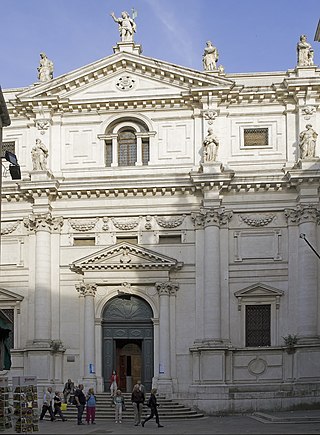
The Chiesa di San Salvatore is a church in Venice, northern Italy. Known in Venetian as San Salvador, is located on the Campo San Salvador, along the Merceria, the main shopping street of Venice. The church was first consecrated in 1177 by Pope Alexander III shortly after his reconciliation with Emperor Frederick Barbarossa at nearby San Marco. The present church, however, was begun in around 1508 by Giorgio Spavento and continued after his death the following year by Tullio Lombardo, Vincenzo Scamozzi and possibly Jacopo Sansovino. They built a large hall church, formed from three Greek crosses placed end to end. Each has a dome with a lantern to let light into the cavernous interior. The facade was added in 1663 by Giuseppe Sardi.

Francesco Vecellio was a Venetian painter of the Italian Renaissance. He was the elder brother and close collaborator of the painter Tiziano Vecellio ("Titian").

The Crucifixion is a life sized painting by the Venetian artist Titian, completed in 1558 and presently hanging in the sanctuary of the church of San Domenico, Ancona. Jesus Christ is shown crucified, with Saint Mary and Saint John standing either side of the cross in the Stabat Mater tradition. The kneeling figure is of Saint Dominic. The canvas was completed during Titian's fifth decade of painting, and is one of the works marking a shift toward his extensive exploration of tragedy and human suffering.
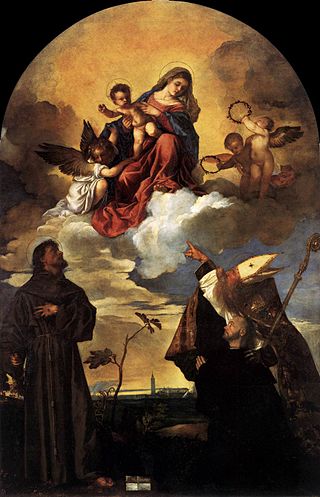
The Gozzi Altarpiece is an oil painting by the Italian Renaissance master Titian, dating from 1520. It is located in the Pinacoteca civica Francesco Podesti in Ancona, central Italy.
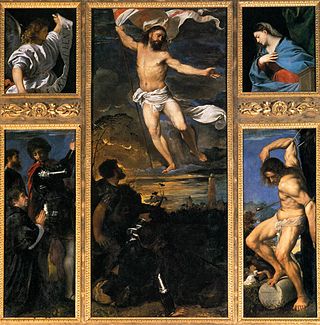
The Averoldi Polyptych, also known as the Averoldi Altarpiece, is a painting by the Italian Renaissance painter Titian, dating to 1520–1522, in the basilica church of Santi Nazaro e Celso in Brescia, northern Italy.
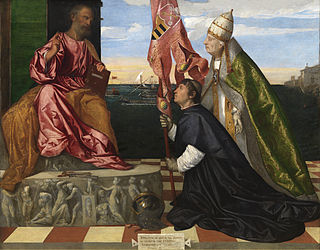
Jacopo Pesaro being presented by Pope Alexander VI to Saint Peter is an oil painting on canvas by Titian, now in the Royal Museum of Fine Arts in Antwerp.
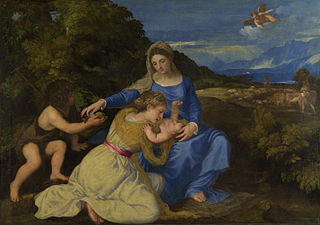
The Aldobrandini Madonna is an oil painting on canvas by Titian, dating to around 1530 and now in the National Gallery, London. There are studio copies in the Galleria Palatina in Florence and in the Kunsthistorisches Museum in Vienna.
Francesco da Milano was an Italian painter from Lombardy. He was active between 1502 and 1548 and twenty of his works in oil-on-canvas and fresco survive in the hill-country of Treviso and Friuli, including a fresco cycle at Castello Roganzuolo. As a Lombard, some aspects of his style were influenced by Bernardo Zenale and Vincenzo Civerchio, though he was also influenced by Titian, who like him lived and worked in the "contrada de Piai" in Serravalle. Titian was preferred to Francesco by Serravalle's town council - Francesco had been the initial choice to paint the Serravalle Altarpiece.

The Castello Roganzuolo Altarpiece, Castello Roganzuolo Polyptych or Madonna and Child with Saint Peter and Saint Paul is a painting by Titian, commissioned in 1543 by the leading citizens of Castello Roganzuolo, Province of Treviso, Veneto, Italy. It is now in the Albino Luciani Diocesan Museum in Vittorio Veneto.

Madonna and Child with Saint George is an oil on panel painting by Correggio dating to around 1530 and now in the Gemäldegalerie in Dresden.

The Scuola del Santo or Scoletta was the headquarters of the Archconfraternity of St Anthony of Padua. It overhangs the churchyard of Basilica of Saint Anthony of Padua, next door to the St. George's Oratory.

The Lochis Madonna is an oil on panel painting attributed to Titian and dated to around 1508–1510. It is now in the Accademia Carrara in Bergamo. It is first recorded as part of the Lochis collection, after which it is named.
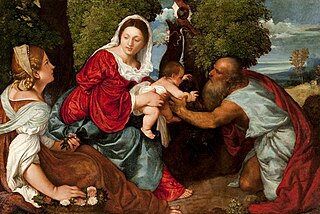
Madonna and Child with Saint Jerome and Saint Dorothy is a 1516 oil on canvas painting, now in the Kelvingrove Art Gallery and Museum in Glasgow, which purchased it from the McLellan collection in 1856. The Madonna's pose is based on that of Raphael's Esterhazy Madonna.

The Assassination of Saint Peter Martyr was a 1528-1529 altarpiece in oils by Titian, originally painted on panel and later transferred to canvas. It was "destroyed by an Austrian shell", or the resulting fire at Santi Giovanni e Paolo, Venice in 1867, though a 1691 copy by Johann Carl Loth hangs in its place. It was reproduced as a print under Titian's supervision, and was highly influential. It was 500 x 306 cm, one of Titian's pioneering large vertical altarpieces.

Madonna and Child with Saint Catherine of Alexandria is a c.1550 oil on panel painting by the studio of Titian, now in the Galleria degli Uffizi. It was restored around the end of the 18th century, when the present carved and gilded frame was probably added.

Madonna and Child with Three Saints or Adoration of the Christ Child with Saints is a c.1519 oil on canvas painting by Titian, now in the Alte Pinakothek in Munich. From left to right the adoring saints are Francis of Assisi, Jerome and Anthony Abbot.

Christ Appearing to his Mother after his Resurrection is a 1554 oil on canvas painting by Titian. He painted it whilst in Medole in Mantua, where he was staying with the archpriest of Assunzione della Vergine, the town's parish church, the church in which it still hangs. It forms part of a series of works planned in his old age by the artist and it is his only altarpiece still in the province or city of Mantua.



















